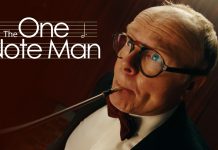Marilyn Cooke reflects on the first steps of a woman entering the legacy of her family in the short drama No Ghost In The Morgue.
Film And TV Now spoke with the film-maker about the short.
The story is of a woman who challenges herself to go her own way. What was the start-off point for the short?
I love to focus on Black women finding themselves, and I love exploring them as complex and full lead characters. At its core, the story is about trusting yourself, and trusting that feeling within yourself that knows when you have found your purpose.
I actually started writing the film during the pandemic. I had wanted to make a story with grandmothers and dreams for a while prior to that. Then I had an experience with someone very close to me dying. I met a mortician who spoke to her “patients” (as she called them) with so much compassion and care that it really stuck with me.
So then I thought: why not explore the experiences around death and family, and bring these ideas together of the morgue and spirits of grandmothers, but in a beautiful and poetic way.
The visual style reminds one of some of David Cronenberg’s early main works like SHIVERS, RABID and THE BROOD. Who and what are your key cinematic influences?
First of all, it’s an honour to compare the film to Cronenberg’s!
His films have a deliberate stillness to them that is unnerving. There is a certain maximalism to his approach that I find inspiring as well, you know you’re always going to be destabilized in some surprising way. I love the unapologetic weirdness of his films. In that sense his films are an inspiration.
I have been a big fan of the work of Miryam Charles for many years. Her films tend towards experimental, they present a succession of images shot on film and soundscapes that give off an atmosphere, a rhythm and an emotion that leave me with an impression of both deja vu and eeriness.
I love Mati Diop’s Atlantics. The fantasy and realism that intertwine to create a well-balanced symbiosis was a revelation for me. In addition to having several characters of complex black women, the images are particularly spellbinding! The supernatural themes resonate with me enormously too, as well as the images of nature which are used as metaphors (the moon, the waves).
Lately, I’ve also been on a Jean-Marc Vallée binge. I love his cinematography and his editing style that always serve the story, but is a way into the subconscious. He has a great sense of character.
Tell us about your cast.
Schelby Jean-Baptiste is our amazing lead actress, she truly carries the film as Keity, the main character. It’s a really introspective role and also quite physical in a way.
She doesn’t speak many lines as Keity, but she embodies her inner world, her anxieties, her weariness in such a beautiful and expressive way in every scene. I actually had her in mind when I was writing the script!
Mireille Métellus, who plays the grandmother, is an acting legend in her own right in Montreal and beyond. She is a trailblazer in theatre, television and film, she has worked with Raoul Peck, she has been to Cannes!
I humbly asked her to participate in the film, praying that she would say yes. She just naturally possesses that queenly composure.
Michel Laperrière, who plays the talkative head pathologist was a no-brainer for me too. He is a well-known character actor in Quebec, and I just hoped he would accept, and I was grateful when he did!
Ariane Bérubé who plays Erykah, the resident in the morgue, really brought a quirky energy to the film as well. She did a fantastic job upping the ante of discomfort and awkwardness in her interactions with Keity. The goal was to show that Erykah is almost more comfortable being around the dead than the living.
Tell us about your production team.
I approached Kélyna N. Lauzier, my producer at the very very beginning of the project.
She had worked in the production team on my previous short film. She also is the founder of the production company La 115e. We work really well together and we have a similar creative vision. She was the first to read the script, she is amazing at giving feedback.
As an artist it can be hard to receive feedback, we can be sensitive about what we create! I truly believe we are a dream team. We are actually collaborating on my upcoming feature film. Producer Macha Houssart was also an essential part of the team, helping us move forward at key moments.
Where did you shoot and for how long?
We shot for four days in and around Montreal. Funny story, the morgue was actually a kitchen! It was in a hotel basement in downtown Montreal.
The dream space where the grandmother “lives” was a commercial garden center, it was a greenhouse that looked nothing like it does in the film. I really have to credit the amazing work of my production designer Maryse Touchette for creating these spaces and bringing it all together.
The operating room in the beginning is in an educational wing of a large university hospital, it’s a non-functional operating room used by medical students.
Would you be keen to develop the issues and themes explored in this short into a feature project?
I would, and I’m doing it right now as I’m currently writing my first feature! It weaves the same themes of family, death and the importance of legacies. I’m moving away from the medical setting though, as my two short films have explored those and I feel that’s enough for me!
There is a delicate balance of drama and humour, particularly in the context of a morgue. How challenging was it to create and then maintain that balance?
It was really important for me that the film be multi-genre in its approach, to incorporate drama with moments of comedy and a hint of fantasy.
It was a challenge because we didn’t want the humour to take too much space, but I didn’t want it to feel too weighty either. I wanted the audience to have a sense of hope and of things falling into place at the end. The past couple of years were already so full of tragedy for many of us, I don’t find it useful for my film to show the same things you would see on the news.
Did you rehearse much with the actors?
We had readings but not much in the way of rehearsals. It was right in the height of the pandemic, so we mostly had Zoom meetings or calls before the shoot.
For Michel (who plays the head pathologist) we actually met in person on the first day of shooting. There is something that you get from a person’s energy from in-person interactions that simply can’t be replicated online in my opinion.
We shot during the height of the pandemic so that was tough as well. Fortunately, it works out with the story, subject matter, and environment of the morgue that they would wear masks. It was important to me that the actors’ performances be felt even though they were wearing masks, without it appearing vaudevillian.
Your focus is on the black female experience. What would you like to see more of in other people’s work that would be progressive?
Wow, what a great question! I would love to see more people telling their own stories and seeing more black women as multidimensional main characters in all their flaws and glory. Issa Rae and Michaela Coel do this superbly.
Showing black women who experience joy and sisterhood as well. I would love to see black actresses as stars of romantic comedies and see them being desired, appreciated and praised for their qualities. Not perfect women who have everything under control, but real humans.
Personally, I’m tired of seeing the downtrodden, beat-down Black woman trope. I’m glad we’re moving past that in terms of representation. I believe joy can be a powerful form of resistance.
Who would you like to work with in the future?
Viola Davis or Olivia Colman: I would love to experience how it is to work with someone who possesses that level of acting ability.
Issa Rae is also someone I would love to collaborate with, although I would probably just fangirl over her for the first hour, I would be so starstruck! Same goes for Michaela Coel, they are both GOATs in my opinion.
There are two DPs I’d love to work with: Sara Mishara from Montreal, she seems to be able to do magic with light. Also Ari Wegner, I was struck by the mood she set in The Power of the Dog and Zola.
What issues and themes are you keen to explore in future work?
I want to dive deeper into dysfunctional family dynamics, which fascinate me because they can be a great source both of comedy and of drama, depending on how you look at it.
I also want to explore storytelling in a more visual way by creating worlds that reflect reality but in a heightened or stylized way. I think the genre-blending approach is so appealing to me for that reason, and magical realism in particular is a fertile ground to create a truly unique universe.
Climate change is also a preoccupation that is close to my heart. I think it’s an issue that is not only thematically rich, but we need to create stories that will reach wider audiences and that will have an impact.
How has the festival circuit helped your film?
It has been huge for the film itself! For shorts, one of the hard parts is having it seen. You want it to get out there and get seen by as much people as possible. I want to give a shout out in that regard to my distribution team at H264, who did an amazing job with their festival strategy. The festival run has been fantastic for visibility, just in terms of getting the film out there, helping it find an audience.
On a more personal note, it’s been really rewarding to actually see the film play in theatres, to travel with the film and meet the public again with live Q&As. We can’t downplay that film as a medium is so powerful as a collective experience. I’ve had people reach out to me at festivals I’ve been, and also on social media. Those have been incredible experiences.
Finally, what are you most proud of about this short?
I’m proud of what we were able to accomplish as a team in a production context that was not easy. I was stressed out before the shoot because the vision I had for the film was risky — it was really ambitious on paper.
Many times I turned to my producer Kélyna and I was like: “Are we really going to be able to pull this off?”. She would always say: “We’ll find a way!” and we always did. But the whole thing could have crashed and burned. I have no one else but my amazing cast, crew and all our collaborators to thank.
They brought to life a superb visual style (shoutout to amazing DP Juliette Lossky and colorist Simon Boisx) and soundscapes (shoutout to sound designer Oliver Calvert).


































